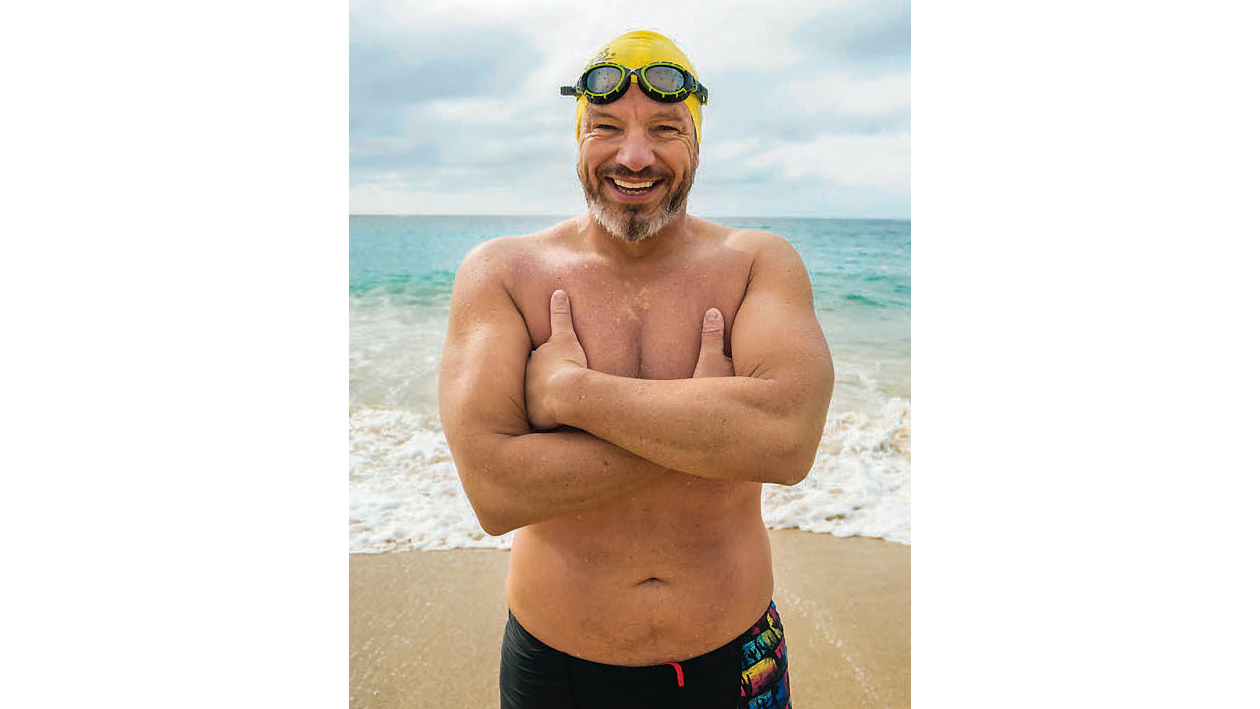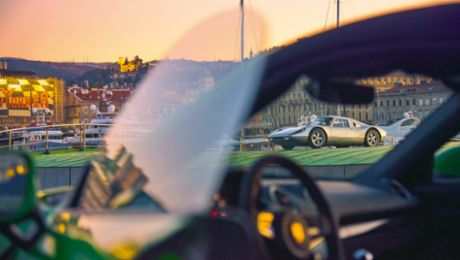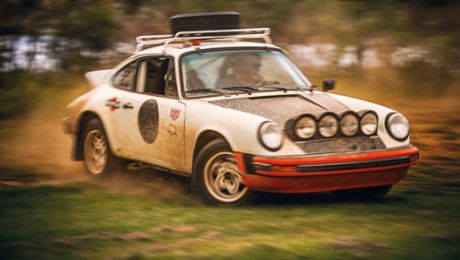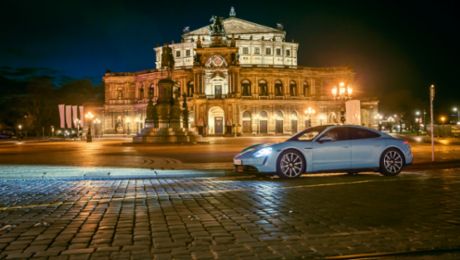Six years ago. That was when André Wiersig and Wolfgang “Wolli” Elges pushed this silver Porsche 911 Coupé into a garage in Paderborn. First registered in 1977, it has a 2.7-liter engine, 121 kW (165 hp), and a black leather interior. “In 2014 the car was actually in quite good and drivable condition,” says Wiersig. “But Wolli wanted original seats with a pinstripe look, and then he wasn’t satisfied with the existing paint job, and then he wanted the technical systems to be absolutely perfect—it was one thing after the other.” So the two friends launched a comprehensive restoration project with the goal of achieving its original condition.
They removed the paint, reworked the engine, and went searching for original parts. Wiersig threw himself into the task. That’s what this forty-seven-year-old likes to do after a day at the office. “I’d go crazy if I spent all my time talking and writing,” he says. Wiersig is the head of sales and marketing for an SAP consultancy, and this 911 isn’t the first Porsche he and Elges have worked on together. They met as teenagers and have been friends ever since. Sports and tinkering with Porsches forge strong bonds.
Six years. There are two main reasons why restoration work has taken this long. The first is Wolli’s meticulous approach. The second is Wiersig’s discovery of a second passion. The story of this second passion began in February 2012 at a beach on the Spanish island of Ibiza. As he did every summer, Wiersig wanted to swim out to a buoy just three hundred meters away. But the 14-degree Celsius water of the Mediterranean Sea shocked his system and brought his body to a halt. “That was an entirely new experience for me,” he recalls. “I couldn’t swim, and the cold was positively painful.” The incident disturbed him, because he had always succeeded in every type of athletic endeavor. He had been an excellent swimmer in his youth and later put his energy into triathlons. As an amateur at the Ironman competition in Hawaii in 2003, he had posted an impressive 183rd place. While still in Ibiza he resolved to reach the buoy the following year.
He started by taking only cold showers. Then he installed a tub in his carport and crouched up to his neck in ice water while his wife and children were lounging on the cozy sofa. Can you get used to cold? “Never!” exclaims Wiersig and bursts out laughing. But he wanted to find out what was possible and leave his comfort zone. The next year he reached the buoy—and then chose a new goal.
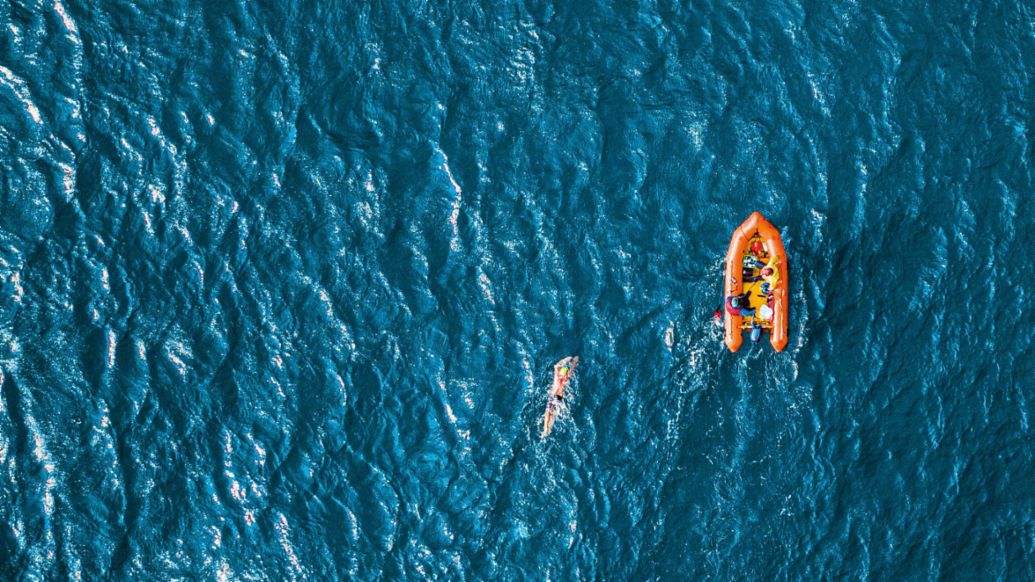
He set his sights on the English Channel. The regulations of the Channel Swimming Association are draconian. Swimmers are accompanied by a boat for documentation purposes but may not touch it. Neoprene suits are forbidden, which is why many open-water athletes wear their own natural insulation underneath their swimsuits and caps. With broad shoulders and a vice-like handshake, Wiersig too wears “bioprene,” as he calls his protective suit. “You need the reserves of fat for the day you swim.”
When he conquered the open-water community’s most famous stretch in September 2014—swimming from Dover to Calais—his eyes were solely on performance. He succeeded in overcoming the cold, gulped down high-calorie liquid food from containers regularly plucked off a pole extended from the boat, and mastered the power of the tides and the currents. The linear distance was 33.2 kilometers. The distance he swam was 45.88 kilometers. And it took him nine hours and forty-three minutes to do it. On his very first try. He had never felt better in his life. Mission accomplished. But then he recalled an article about the Irishman Stephen Redmond. In 2012 he was the first person to swim the Ocean’s Seven. Wiersig’s next goal began to take shape.
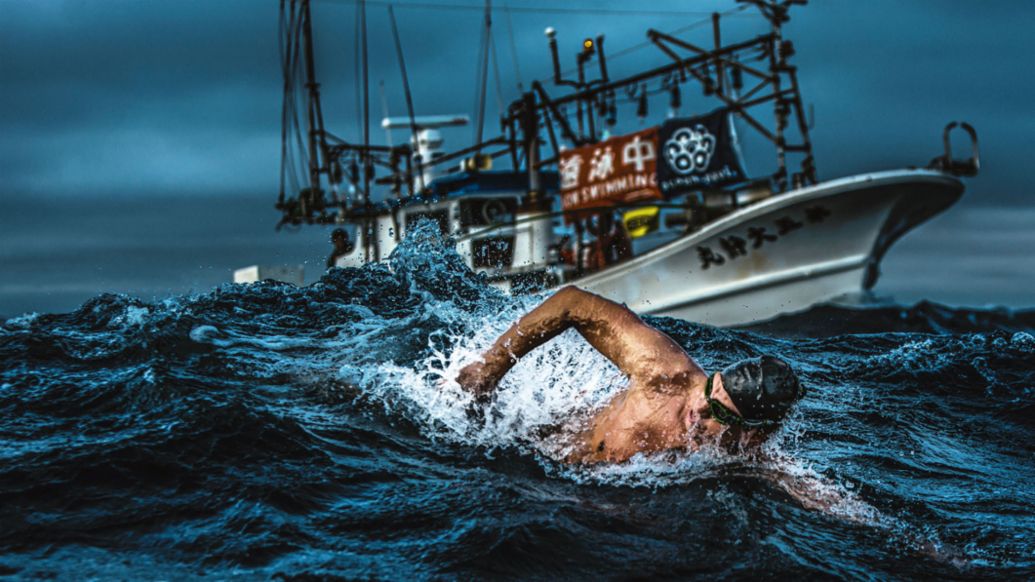
He commuted from his home in Paderborn to his job in Hamburg. Short on time, he invented unorthodox training methods—compressed periods of exertion after work. “Sometimes I lifted so many weights in the evening that I could hardly take off my clothes,” he recalls. Only after training for strength did he get into the water. Hour after hour alone at night in the indoor pool. “The idea was to be able to keep going in a state of total exhaustion.” Beate Wiersig—they’ve been married since 2000—doesn’t have it easy with him. She and their three children were haunted by the fear of losing him at sea. André later apologized to the love of his life for all the imposition, concern, and worry.
In the meantime, Wiersig began to explore new horizons on stage two of the Ocean’s Seven. In 2015, in the Pacific between the Hawaiian Islands of Molokai and Oahu, he experienced not only the athletic ambition of near superhuman self-mastery but also an intimate connection with the element that holds him: becoming one with the open sea. He visited Baron Josef Kerckerinck zur Borg, a shark protection expert, to prepare for encounters with these predators. He also tried to steel himself mentally for contact with a Portuguese man-of-war—one of the world’s most poisonous jellyfish.
The night he did in fact swim into one of these creatures, the pain was so intense it felt as if his left arm had been bitten off. He considered giving up. But he realized, “If I stop now, the pain will still be there on the boat.” So he kept swimming, was stung multiple times, met an enormous whale and then a blue shark that appraised him for minutes. Shortly before reaching the finish, a current held him back for hours. After the staggering period of eighteen hours and forty-six minutes, he finally reached the shore. Beate and his family were waiting for him.
The greatest challenge of all? Wiersig doesn’t even have to think twice before answering: “The North Channel between Northern Ireland and Scotland in 2016.” A linear distance of around thirty-five kilometers, gusty winds, numb extremities in ice-cold water, paralyzed facial muscles, a brutal current, and huge lion’s mane jellyfish all around. Toward the end of the swim, Wiersig had reached his limit. The captain of the boat accompanying him wanted to call it quits. An oncoming storm was ever more a threat. Wiersig’s brother-in-law, who was giving him food from the boat, shouted, “You have to swim faster!” Wiersig swam faster. Twelve hours later he reached the rocky coast in tumultuous waves—and hardly managed the last few meters to the safety of the boat. He has never been closer to death than in those few moments.
“The depth and the darkness trigger fears, and your eyes have no distractions as with jogging or cycling. The darkness exacerbates the isolation, vulnerability, and sense of being lost.” André Wiersig
The straits off New Zealand and Japan also saw him push the limits of what is humanly possible. His love of the sea grew and increasingly eclipsed his athletic ambition. When, in Japan, a squared sea with waves of crossing currents literally tossed him into the air, he reveled in the ocean’s power. When he climbed up a rock in the middle of the night to start his crossing of the Tsugaru Strait, he awakened a seal and stared it right in the eyes.
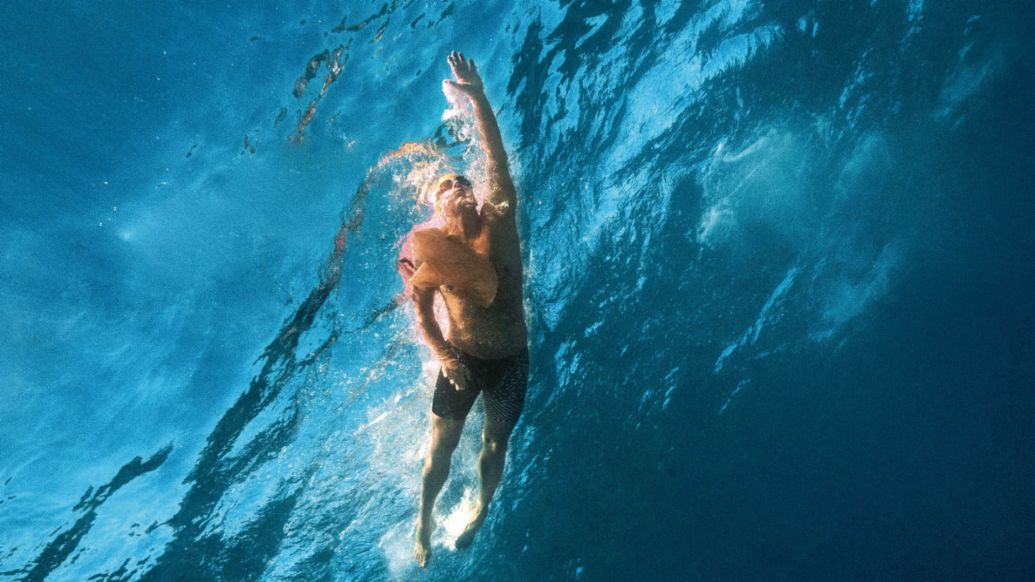
Wiersig rhapsodizes about the sunlight sparkling on schools of fish right below the water’s surface and bioluminescent plankton through which his arms left trails of light as he crossed the Catalina Channel. “It looked like streaks of fairy dust from Peter Pan,” he says.
What motivates him most today? Water’s ability to sharpen his perception. “The longer you swim, the more extreme your senses become. You’re incredibly vulnerable, and you immediately know when the water becomes just a tenth of a degree colder; in essence you become one with the sea.” He’s increasingly frustrated by the presence of objects that don’t belong in the ocean. “I’ve swum into plastic sheeting and nearly died of fright,” he says. He’s constantly running into trash; in the English Channel he bumped his head on a Euro pallet.
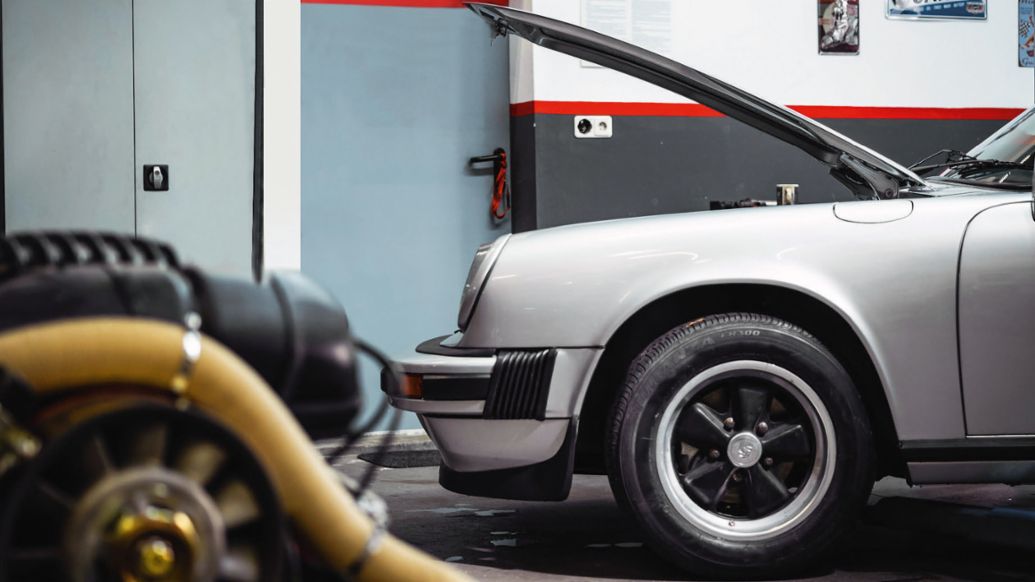
In an effort to stem the rising levels of pollution, Wiersig works as an ambassador for the German Ocean Foundation. The oceans have become the focus of his life. He gives talks about them, inspiring children and companies alike to work to save them. In the beginning he got in the water because he wanted to swim, he says. “But now I swim because I want to be in the ocean, which I love so much.”
In 2013 he began training to swim across the English Channel. In June 2019 he crossed the Strait of Gibraltor and became the sixteenth person ever to complete the Ocean’s Seven. Six years! Six years of dedication and of teetering on the brink of losing himself and everything he holds dear. He looks back and shakes his head in disbelief. Was that really me? Family and a normal life are now his priorities, as well as reflecting on what he has accomplished. And yes, for André Wiersig, working on a Porsche with his friend Wolli is about the most relaxing thing he can do. At any rate, the 911 is now completely ready for a new adventure.
These are the Ocean’s Seven
The Ocean’s Seven were designated in 2009 by Steven Munatones from the USA. The name reflects the seven summits of extreme mountaineering, that is, the highest peak on each of the seven continents. André Wiersig swam the Ocean’s Seven in the order listed.
English Channel
England – France
Linear distance: 33.2 km
Distance swum: 45.88 km
Time: 9 h. 43 min.
Kaiwi Channel
Molokai – Oahu (Hawaii, USA)
Linear distance: 44 km
Distance swum: 55 km
Time: 18 h. 46 min.
North Channel
Northern Ireland – Scotland
Linear distance: 34.5 km
Distance swum: 52.04 km
Time: 12 h. 17 min.
Catalina Channel
Catalina Island – Los Angeles (USA)
Linear distance: 32.3 km
Distance swum: 40.6 km
Time: 9 h. 48 min.
Tsugaru Strait
Honshu – Hokkaido (JP)
Linear distance: 19.5 km
Distance swum: 42.1 km
Time: 12 h. 55 min.
Cook Strait
South Island – North Island (NZ)
Linear distance: 22.5 km
Distance swum: 32.9 km
Time: 8 h. 2 min.
Strait of Gibraltar
Spain – Morocco
Linear distance: 14.4 km
Distance swum: 18.2 km
Time: 4 h. 17 min.
SideKICK: Top quality thanks to recycling
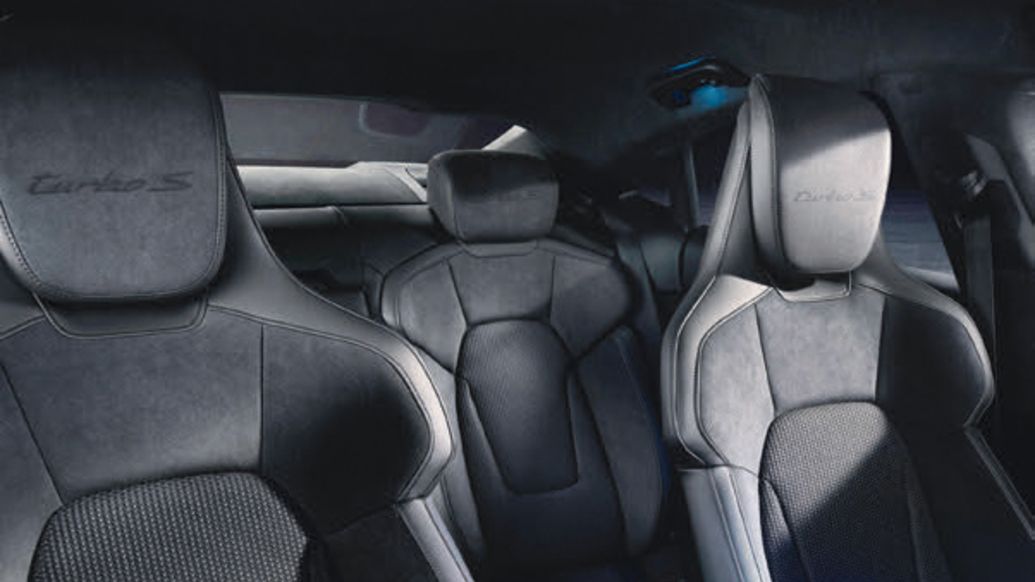
Porsche is placing an ever-greater focus on sustainable materials. An example of this is its use of Econyl in the Porsche Taycan’s floor covering. High-grade Econyl fiber is spun from 100 percent recycled polyamide 6 (PA6). At least 50 percent of the PA6 used is acquired directly from postconsumer waste, such as discarded fishnets and old shag carpets. Compared to conventional PA6, every ton of Econyl raw material saves seven barrels of crude oil, avoids emitting 5.7 tons of CO₂, and lowers the greenhouse effect of nylon by up to 80 percent.
Info
Text first published in the Porsche magazine Christophorus, No. 395.
Copyright: The image and sound published here is copyright by Dr. Ing. h.c. F. Porsche AG, Germany or other individuals. It is not to be reproduced wholly or in part without prior written permission of Dr. Ing. h.c. F. Porsche AG. Please contact newsroom@porsche.com for further information.


